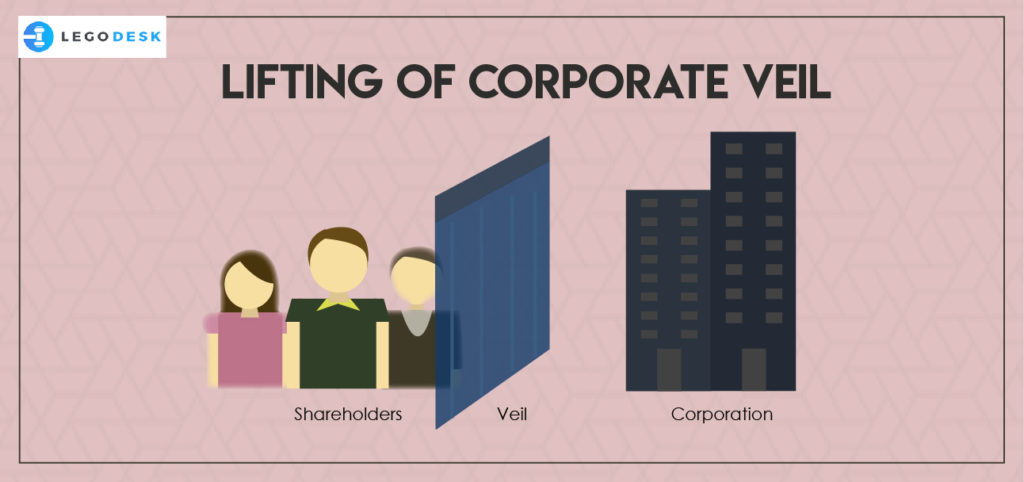Concept of Lifting of Corporate Veil
Introduction To Lifting of Corporate Veil

The corporate veil is a concept which provides that the personality of a company has to be treated separately from that of its shareholders. It also protects the shareholders from being held personally liable for the company’s debts and other obligations. The Cambridge Dictionary defines corporate veil as the idea that a company’s managers or shareholders are not legally responsible for the action of the company: Shareholders may hide behind the corporate veil, assured that their liability does not extend beyond the value of their shares.
The essential term that needs to be understood for this concept is what a company means. Section 2(20) of the Companies Act, 2013 defines a company as a company incorporated under the Companies Act 2013 or any previous company law. A company is a separate legal entity and has a personality of its own.
This feature was established by the Supreme Court of India in the case of Rustom Cavasjee Cooper vs. Union of India. The court stated that “a company registered under the Companies Act is a legal person, separate and distinct from its individual members. Property of the company is not the property of the shareholders”.
But this protection is not impenetrable, under the legal concept of the lifting of the corporate veil, the courts may hold the shareholders liable for the company’s obligations. At many times it happens that the corporate identity of a company is used to commit some fraud or illegal activity. In this situation, the concept of the lifting of the corporate veil is initiated. The corporate personality of the company is disregarded in order to look out who were the people involved in that fraudulent act. In simple words, the veil of separate corporate personality is lifted and the real culprits behind the veil are held liable, as an exception to the rule of protection under a corporate shell. In the United States, there are two important theories prescribed for the creation of piercing standard-
- Alter ego theory- consider (if there is) the distinctive boundaries between a corporation and it’s shareholders.
- Instrumentality theory- examines if the corporation has been used in any way by its shareholders for their own benefits instead of the corporate.
The basic concept of the lifting of the corporate veil can be categorized broadly under two categories-
- Statutory Provisions
- Judicial interpretation
1. Statutory Provisions
The Companies Act, 2013 provides various provisions which point out the person which should be held liable for the fraud or illegal activity. Section 2(60) of the act states that these people (directors or key managerial positions) are to be referred to as “officer who is in default”. Some of these provisions are listed below.
- Company’s name- When the approved name of the company is used, it makes the contract legally binding. If any representative or shareholder of the company enters in incorrect details of the company and sign on behalf of the company, should be held liable.
- Misstatement of the prospectus- If a person publishes false or untrue statements in a company’s prospectus, that person would be punished under Section 26 (9), Section 34 and Section 35 of the Act.
- Investigation of ownership of the company- section 216 of the Act states that inspectors can be appointed to investigate, by the central government, on matters relating to the company.
- Liability for fraudulent conduct- Section 339 of the Act provides that if it appears that fraudulent activities were being carried out in the name of the company, the court can hold the people involved liable.
- Inducing persons to invest- Section 36 of the Act states that any person who by false and deceptive measures, induces some other person to enter into an agreement will be held personally liable under Section 447 of the Act.
2. Judicial Interpretation
Besides Statutory provisions, the judiciary has played an important role in lifting the corporate veil as well. Some cases where the judiciary performed its role are listed below.
- In Tata Engineering and Locomotive Co. Ltd. v. the State of Bihar, the Supreme Court of India stated that a company is not allowed to lay a claim on the fundamental rights on the basis that the company is an aggregation of citizens. When a company is formed, the business that is carried by the company is the business of the company only, and not of the citizens who formed the company.
- Judiciary is empowered to lift the corporate veil if the conduct of a company is in conflict with the public interest. In Jyoti Limited vs Kanwaljit Kaur Bhasin And Anr., the Delhi High Court held that corporate veil can be lifted if the representative of the company commits contempt of the Court.
Conclusion
Many individuals try to misuse their power under the corporate shell for their own benefits as they are protected under the corporate veil. But the concept of the lifting of the corporate veil is a powerful weapon in the hands of the judiciary. It makes sure that no individual gets to perform illegal acts under the company name and walk free. It acts as a watchdog over companies. The personality of a company is surely separate from that of the shareholders of the company, but this doesn’t mean that the shareholders can do wrong hiding behind the corporate veil.
References-
- Companies Act, 2013
- 1970 A.I.R. 564
- [1964] 34 Comp. Cas. 458(SC), AIR 1965 SC 40
- 1987 CriLJ. 1282
Try our Debt Resolution solutions today Request a Demo